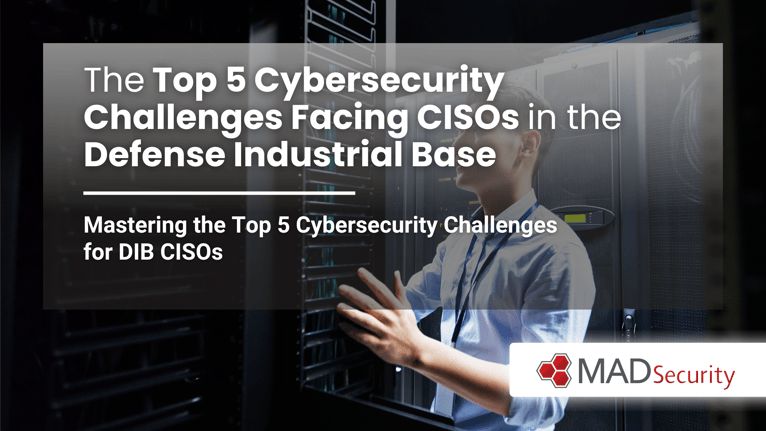
As hackers increasingly target the networks and data of aerospace, arms manufacturers, and other companies that make up the Defense Industrial Base (DIB), Chief Information Security Officers (CISOs) in this sector face immense challenges safeguarding critical systems and intellectual property.
In this blog, we’ll cover the five most pressing cybersecurity issues occupying CISOs in the DIB space and best practices for mitigating risks:
Achieving CMMC Compliance
The Cybersecurity Maturity Model Certification (CMMC) is a sweeping new regulatory framework set in motion to be mandated by the Department of Defense to bolster security across the 300,000+ companies in its supply chain. While defense contractors are growing accustomed to compliance with established standards like NIST 800-171, preparing for CMMC audits represents a significant undertaking.

CISOs report that the breadth of CMMC controls and lack of assessors has made planning and achieving certification within required timeframes difficult. Focus areas include:
-
Assessing systems against CMMC shifting requirements.
-
Implementing needed cybersecurity improvements and controls.
-
Developing Plan of Action and Milestones (POAMs) to close gaps.
-
Ensuring proper policy, training, and documentation for practices.
-
Preparing for mock audits and assessments.
Expert partners can help map current state security posture to CMMC, architect solutions to attain required Maturity Processes and Capabilities, and get defense contractors truly audit-ready.
Safeguarding Sensitive CUI Data
Protecting sensitive Controlled Unclassified Information (CUI) like designs, specifications, and other intellectual property is imperative, given cyber thieves frequently infiltrate contractors to steal this valuable data.
Steps CISOs are taking include:
-
Locating and classifying all CUI data repositories.
-
Applying stringent controls like encryption, multi-factor access, and database security to CUI.
-
Monitor access and transfers of CUI data.
-
Establish insider threat programs.
-
Conduct security training for all personnel handling CUI.
Robust data security platforms, user behavior analytics, and data loss prevention provide the capabilities to properly safeguard CUI no matter where it resides.
Achieving ITAR/EAR Compliance
Companies exporting defense articles and services must comply with complex regulations like the International Traffic in Arms Regulations (ITAR) and the Export Administration Regulations (EAR). This introduces additional security and access requirements.

To meet ITAR/EAR compliance mandates, CISOs are:
-
Assigning classifications to all hardware, technical data, and technology.
-
Restricting access through need-to-know authorization and controls.
-
Maintaining careful logs and audit trails of export-controlled information access.
-
Establishing comprehensive data security policies and procedures.
-
Conducting stringent screening and training for staff handling controlled data.
Advanced cybersecurity tools provide the capabilities to meet ITAR/EAR control, auditing, and reporting requirements.
Countering Nation-State Threats
Due to the sensitive nature of their intellectual property and R&D, defense contractors face sophisticated attacks from China, Russia, Iran, North Korea, and other nation-states trying to steal classified information.
CISOs are working diligently to thwart threats including:
-
Implementing next-gen endpoint, firewall, intrusion prevention, and email security.
-
Performing extensive system and network vulnerability assessments.
-
Monitoring threats with 24/7 security operations centers (SOCs).
-
Using deception technology to identify malicious actors.
-
Establishing insider threat detection programs.
-
Conducting regular penetration testing and red team exercises.
Expert third-party resources can help monitor for nation-state intrusions, investigate any incidents, and offer guidance to boost threat intelligence and defense capabilities.
Managing Third-Party Cyber Risk
With expansive supply chains, CISOs in the DIB sector also face the challenge of managing the cyber risk presented by third-party partners, vendors, and contractors. Steps to secure the extended attack surface include:
-
Vetting suppliers through cyber questionnaires and documenting security expectations in contracts.
-
Implementing vendor risk management programs to continuously monitor supplier security.
-
Performing audits and assessments of third-parties that handle sensitive data.
-
Using tools to model links and risk levels across multi-tier supply chains.
-
Establishing data security guidelines for contractors.
-
Incorporating common standards like CMMC across the supply chain.
Robust third-party risk management programs, assessments, and CMMC readiness services enable CISOs to close gaps across the partner ecosystem.
Gain an Advantage with Cybersecurity Partners
For CISOs in the defense industry, the stakes for protecting IP, weapons systems, and other sensitive data could not be higher. With advanced solutions, experienced advisors, and on-demand cybersecurity talent, it’s possible to tackle the most pressing CMMC, data security, ITAR, nation-state, and third-party challenges.
To learn more about MAD Security’s cybersecurity services tailored to the unique needs of DIB contractors, reach out to us today. Our experts stand ready to partner with you on your mission-critical security initiatives, ensuring your business is secure 24/7/365.
Original Published Date: August 22, 2023
By: MAD Security

